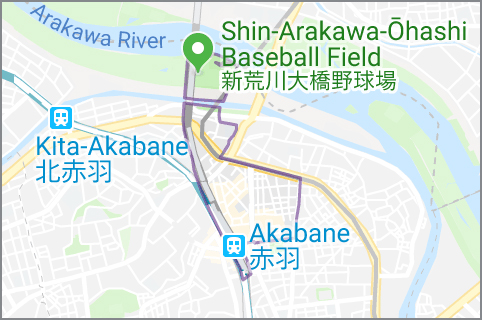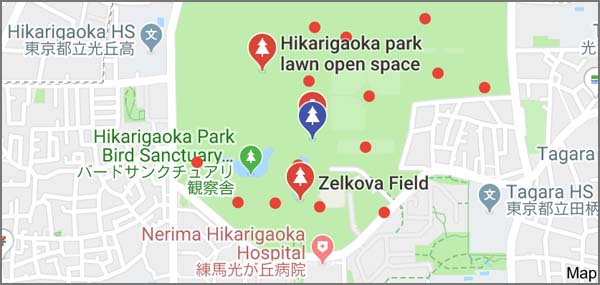. Famous Places and Power spots of Edo 江戸の名所 .
::::::::::::::::::::::::::::::::::::::::::::::::::::::::::::::::::::::::::::::::::::::::::::::::::::::::::::::::::::::::::::::::::::::::::::::::::::::::::::::::::::::::::::::::::::
Tabata 田端 Tabata district
Kita, Tabata 一丁目 - 六丁目 first to sixth sub-district
東田端 Higashi, 一丁目、二丁目 first and second sub-district
田端新町 Shinmachi, 一丁目 - 三丁目 first to third sub-district

The name means 「田の端」にあった町 a town at the end of the fields.
Another spelling is 田畑, meaning many rice and vegetable fields.
In the Edo period, the area was called 豊島郡田端村 Toshima district, Tahata village.
- quote -
Tabata (on the edge of the field)
... In the Edo Period, 田端村 Tabata Mura Tabata Village was located on a section of the elevated area that is geographically referred to as the 上野台地 Ueno Daichi the Ueno Plateau, but was to known at the time as 上野山 Uenoyama Ueno Mountain. The area was well known because one side was bordered by a cliff. Although, most people don’t notice it now, the west side of Tabata Station clearly shows the cliff – it’s just been woven into the fabric of the modern metropolis.
It’s said that meaning of the name is 田ノ端 ta no hata on the edge of a rice paddy. Historical records and maps from the early Edo Period are vague at best, but the area would have been quite rural at the time. The presence of 田畑 tahata rice paddies and fields is more or less a given. Speaking of tahata, a second etymology says that via rendaku, tahata became tabata.

Tabata sits on a ridge – a cliff, if you will – on the edge of the Ueno Plateau. The agricultural lands here were eventually surrendered to the Tokugawa Shōgunate in the name of 参勤交代 sankin-kōtai alternate attendance[ii], for the purpose of building daimyō residences and samurai residences. Without clear historical records, the “edge” could have referred to rice paddies on the plateau itself, or could refer to the cliff – a proverbial “edge” clearly delineating the yamanote and shitamachi, thus indicating the farming was being done in the valley.
A second, more intriguing theory maintains that the place name is most likely far more ancient than the kanji reveal. ... This theory maintains that the oldest place names are all based on the terrain. This theory maintains that the oldest place names are all based on the terrain....
... This alternate theory uses some archaeological findings to back it up. The area has been inhabited since the Jōmon Period but the real activity picked up around the Yayoi Period. During the early to mid Jōmon Period (7,000-4,000 years ago), this area was coastline, and the high areas were inhabited by villagers, communities highly reliant on the sea and not farming. The sea began receding during the Yayoi Period and we find evidence of all kinds of coastal fishing activity, but no farming. Because the only people who farm next to the ocean are idiots.
Again,
if this is an ancient name – not a medieval name – the kanji does not matter. Kanji have sounds (readings) but no kanji is divorced from meaning. It always has a meaning. Going by this theory, the archaeological evidence has led a small group of people to maintain that the name comes from a very ancient place name that originally meant “the top of the plateau.” One of the more interesting speculations was that the name is evidenced by 束旗 tabahata → tabata a bundle of flags, because the high ground is where you can build your fort (and of course put up your flags, which can be seen from everywhere).
- source : Marky Star -
.......................................................................

Atrevie Tabata アトレヴィ田端
Finished in 2008.
Tabata station, 1 Chome-17-2 Higashitabata, Kita
.......................................................................

田端文士村記念館 TABATA Memorial Museum of Writers and Artists
6 Chome-1-2 Tabata, Kita
Admission - Free
- source : kitabunka.or.jp/tabata -
..............................................................................................................................................
. 宝珠山 / 寶珠山 Hojuzan 地蔵院 Jizo-In 与楽寺 Yoraku-Ji .
北区田端1-25-1 / 1 Chome-25-1 Tabata, Kita
Dairyuuji 大龍寺 Dairyu-Ji
東京都北区田端4-18-4 / 4-chōme-18-4 Tabata, Kita

With the grave of the haiku poet
. 正岡子規 Masaoka Shiki .
. Toogakuji 東覚寺 Togaku-Ji .
北区田端2-7-3 / 2 Chome-7-3 Tabata, Kita
Nearby is
田端八幡神社 Tabata Hachiman Jinja
東京都北区田端2-7-2 / 2 Chome-7-2 Tabata, Kita

- quote -
The shrine is located right next to Tokakuji Temple.
It's told that this shrine started when Minamoto no Yoritomo, founder of the Kamakura government, stopped by on his way back to Kamakura after the conquest in North Japan, at the end of 12th century.
- source and photos : richiefukuda.blogspot.com... -
上田端八幡神社 Kami-Tabata Hachiman Jinja
東京都北区田端4-18-1 / 4 Chome-18-1 Tabata, Kita
- reference source : tesshow.jp/kita/shrine_tabata... -
::::::::::::::::::::::::::::::::::::::::::::::::::::::::::::::::::::::::::::::::::::::::::::::::::::::::::::::::::::::::::::::::::::::::::::::::::::::::::::::::::::::::::::::::::::
Ooji, Ōji 王子 Oji district
Kita, Oji 一丁目~六丁目 first to sixth sub-district
王子本町 Oji Honcho (Motomachi) 一丁目 - 三丁目 from first to third sub-district
下十条町 Shimo-Jujo machi was located in the 東京都王子区 Oji district.
. Juujoo, Jūjō 十条 Jujo district . - Kita

The place where the deity 若一王子 Nyakuichi Oji / 若王子 Nyakuoji from Kumano are venerated.
熊野本宮大社の若一王子
The area was first called 岸村 Kishimura, "village on the shore". After the sharing of a deity from the 熊野本宮大社 Kumano Hongo Taisha in Wakayama a new Shrine was built for the deity
若一王子 Nyakuichi Oji The Srine was named Oji Jinja and the district named
王子村 Oji mura village.
This deity is not a prince, but the special deity
熊野権現 Kumano Gongen.
......................................................................
Ooji Jinja, Ōji Jinja 王子神社 Oji Shrine
王子本町1丁目 / 1 Chome Ojihoncho, Kita

source : wikipedia
In this shrine Kumano Gongen 熊野権現 is venerated.

The Shrine is famous for its huge 王子神社のイチョウ gingko tree.
The local deities in residence are
Semimaru ko 蝉丸公(神霊) (a poet of the Heian period)
Sakagami hime 逆髪姫(神霊)
Furuya bijo 古屋美女(神霊)
Deity of hairstyle 髪の祖神
The Oji Shrine was founded in the 14th century. It is situated on a hill and from there you have a great view.
The shrine buildings of today were reconstructed after WW II.

.......................................................................
. Ooji Inari Jinja 王子稲荷神社 Oji Inari Fox Shrine .
1-12-26,Kishi-Machi,Kita-Ku,Tokyo / 東京都北区岸町1-12-26
This shrine was also called Kishi Inari 岸稲荷.
Once a year on January 1, the foxes from the Kanto region would pay a visit to the great fox shrine . . .
.......................................................................
王子製紙 Oji Paper Company
A paper-making company from the area.
Founded by Shibusawa Eiichi.

- CLICK for more photos !
Kami no Hakubutsukan 紙の博物館 Paper Museum
- reference source : ojipaper.co.jp -
..............................................................................................................................................
- quote -
Ōji Ōgi-ya 王子 扇屋 Oji, Ogiya
During the Edo period,
Ōji bustled as a tourist destination for worshipping Ōji Inari Shrine and waterfall bathing.
It is said that restaurants stood in line near the Otonashi River. Ebi-ya and Ōgi-ya, in particular, were listed in the restaurant ranking of the Edo period.
Ebi-ya was run by the brothers of Ōgi-ya, but only Ōgi-ya remains until now.
- source : Tokyo Metropolitan Library -
::::::::::::::::::::::::::::::::::::::::::::::::::::::::::::::::::::::::::::::::::::::::::::::::::::::::::::::::::::::::::::::::::::::::::::::::::::::::::::::::::::::::::::::::::::

- - - To join me on facebook, click the image !
:::::::::::::::::::::::::::::::::::::::::::::::::::::::::::::::::::::::::::::::::::::::::::::::::::::::::::::::::::::::::::::::::::::::::::::::::::::::::::::::::::::::::::::::::::::
. Kita ku 北区 Kita ward, "Northern Ward" .
. Famous Places and Powerspots of Edo 江戸の名所 .
. Edo bakufu 江戸幕府 The Edo Government .
. Doing Business in Edo - 商売 - Introduction .
. Japanese Architecture - The Japanese Home .
. Interior Design - The Japanese Home .
. Legends and Tales from Japan 伝説 - Introduction .
[ . BACK to DARUMA MUSEUM TOP . ]
[ . BACK to WORLDKIGO . TOP . ]
- - - - - #tabata #oji #ooji #ogiya - - - -
::::::::::::::::::::::::::::::::::::::::::::::::::::::::::::::::::::::::::::::::::::::::::::::::::::::::::::::::::::::::::::::::::::::::::::::::::::::::::::::::::::::::::::::::::::








































